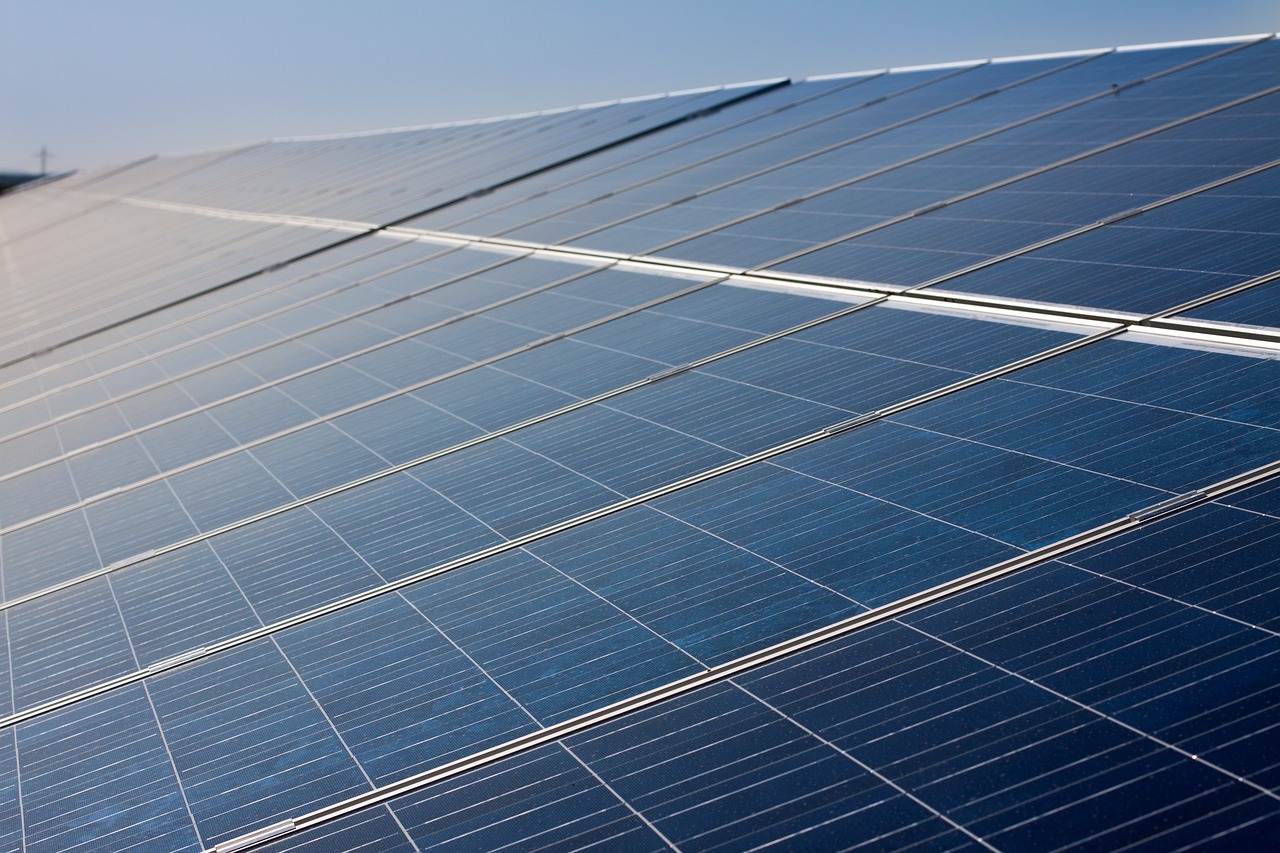Tax Breaks and Incentives for Green Energy Users
In today’s world, where environmental concerns are at the forefront of global discussions, investing in green energy has become more than just a trend—it's a necessity. For individuals and businesses alike, the transition to renewable energy sources can be daunting, both in terms of implementation and costs. However, the good news is that there are numerous tax breaks and incentives available that can alleviate some of these financial burdens. These incentives not only encourage the adoption of sustainable practices but also help in reducing overall tax liabilities, making green energy solutions more accessible and appealing.
Understanding these incentives can feel like navigating a maze, but fear not! The federal government and various state authorities have established programs designed to reward those who make the switch to renewable energy. These programs can significantly lower the initial costs associated with green energy installations, enabling more people to invest in solar panels, wind turbines, and other renewable technologies. Imagine being able to harness the power of the sun or wind while simultaneously receiving financial benefits—it's like hitting two birds with one stone!
Tax breaks can come in various forms, including tax credits, deductions, and even grants. Each of these has its own set of rules and benefits, but they all share a common goal: to promote the use of renewable energy. For instance, the Investment Tax Credit (ITC) allows solar energy users to deduct a substantial percentage of their installation costs from their federal taxes. This can translate into significant savings, making the initial investment in solar technology much more manageable.
Additionally, many states have their own incentive programs that complement federal efforts. These state-level incentives can include rebates, grants, and state tax credits—all designed to further encourage the adoption of green energy solutions. By taking advantage of these various programs, individuals and businesses can maximize their savings and contribute to a more sustainable future. So, whether you're a homeowner looking to install solar panels or a business considering wind energy, understanding these tax breaks and incentives is crucial to making informed decisions.
In summary, the landscape of green energy is evolving, and with it comes a plethora of opportunities for financial savings through tax breaks and incentives. By embracing these options, you not only invest in cleaner energy but also pave the way for a more sustainable and economically viable future. So why wait? Dive into the world of green energy, explore the available incentives, and start reaping the benefits today!
- What is the Investment Tax Credit (ITC)? - The ITC allows taxpayers to deduct a percentage of the cost of installing solar energy systems from their federal taxes.
- Are there state-level incentives for green energy? - Yes, many states offer their own tax credits, rebates, and grants to promote renewable energy usage.
- How can I find out what incentives are available in my state? - You can visit your state’s energy office website or consult the Database of State Incentives for Renewables & Efficiency (DSIRE).
- Do these incentives apply to businesses as well? - Absolutely! Both individuals and businesses can benefit from various tax breaks and incentives for green energy investments.

Understanding Tax Breaks
Tax breaks are like a warm hug from the government, designed to encourage individuals and businesses to embrace environmentally friendly practices. They work by reducing the amount of tax you owe, which can make a significant difference in your financial planning. Think of tax breaks as a way to reward you for making choices that benefit not just your wallet, but also our planet. By investing in green energy solutions, you’re not just saving money; you’re playing a crucial role in the fight against climate change.
So, how do these tax breaks actually function? At their core, they provide financial incentives that can help offset the costs associated with renewable energy investments. For instance, if you install solar panels on your home, the government might allow you to deduct a portion of that installation cost from your taxable income. This means you get to keep more of your hard-earned money, while simultaneously contributing to a more sustainable future. It’s a win-win situation!
The importance of these tax breaks cannot be overstated. They not only help to lower the initial investment barrier for renewable energy technologies but also create a ripple effect that encourages broader adoption. When more people and businesses take advantage of these incentives, it leads to increased demand for renewable energy solutions, which in turn drives innovation and reduces costs further.
To illustrate the impact of tax breaks, consider this: if a small business invests in energy-efficient equipment, the tax deductions they receive can free up capital that can be reinvested into the company. This could lead to job creation, expanded services, and ultimately, a more robust economy. Tax breaks are not just about saving money; they are about creating opportunities.
In summary, understanding tax breaks is essential for anyone looking to invest in green energy. They provide a pathway to financial savings while promoting sustainable practices. By taking advantage of these incentives, you’re not just benefiting yourself; you’re contributing to a larger movement towards a greener, more sustainable world. So, why not explore the options available to you? You might be surprised at how much you can save while making a positive impact!

Federal Incentives for Renewable Energy
The federal government has recognized the importance of transitioning to renewable energy sources, and as a result, it offers a variety of incentives designed to encourage individuals and businesses to make the switch. These incentives are not just a nice bonus; they play a crucial role in reducing the financial burden associated with adopting green technologies. By providing tax credits, deductions, and other financial benefits, the government aims to foster a sustainable energy landscape that can help combat climate change and promote energy independence.
One of the most significant federal incentives is the Investment Tax Credit (ITC), which allows taxpayers to deduct a substantial percentage of the cost of installing solar energy systems from their federal taxes. This means that if you’re considering going solar, the ITC can significantly lower your upfront costs, making it a more attractive option. Additionally, the Production Tax Credit (PTC) provides financial incentives for the generation of renewable energy, rewarding businesses based on the amount of energy produced from renewable sources like wind and solar. These credits not only help offset initial investments but also contribute to the long-term viability of renewable energy projects.
To give you a clearer picture, let’s break down how these incentives can impact your finances. For example, if you invest $20,000 in a solar energy system and qualify for the ITC, you could deduct 26% of that cost from your federal taxes, which amounts to a $5,200 tax credit. This reduction makes solar energy systems much more affordable and can lead to quicker returns on investment. Furthermore, the PTC works similarly, but rather than a one-time deduction, it offers a per-kilowatt-hour credit for energy produced over a specified period, often ten years. This ongoing support can make renewable energy projects much more appealing to investors.
It’s important to note that these incentives are not just limited to solar energy. The federal government also supports other renewable sources, such as wind, geothermal, and biomass, through various programs and tax credits. This broad range of incentives ensures that multiple avenues for clean energy adoption are available, promoting a diverse energy portfolio that can meet our future needs.
However, navigating these federal programs can be complex. Each incentive comes with its own set of eligibility requirements and application processes. Therefore, it’s essential for potential investors to stay informed about the latest updates and changes to these programs. Consulting with a tax professional or a renewable energy expert can be beneficial in ensuring that you maximize your benefits and comply with all regulations.
As we move forward, the federal government continues to evaluate and enhance these incentives to make renewable energy more accessible. By understanding and taking advantage of these federal incentives, you can not only reduce your tax burden but also contribute to a healthier planet for future generations.
- What is the Investment Tax Credit (ITC)? The ITC allows taxpayers to deduct a percentage of the cost of installing solar energy systems from their federal taxes.
- Who qualifies for the Production Tax Credit (PTC)? The PTC is available to businesses that generate renewable energy from sources like wind and solar.
- How can I apply for these federal incentives? You can apply for these incentives through your federal tax return, but it’s advisable to consult a tax professional for guidance.
- Are there deadlines for these tax credits? Yes, many federal incentives have specific deadlines, so it's important to stay updated on current laws and regulations.

Investment Tax Credit (ITC)
The is a game changer for anyone considering the installation of solar energy systems. Imagine being able to deduct a significant percentage of your solar installation costs directly from your federal taxes! That's exactly what the ITC offers, making it an attractive incentive for both homeowners and businesses alike. This credit allows taxpayers to deduct a whopping 26% of the installation costs from their federal tax bill, which can translate into substantial savings. For example, if you invest $20,000 in a solar system, you could potentially reduce your tax liability by $5,200!
But it’s not just about the immediate savings; the ITC plays a crucial role in promoting the adoption of renewable energy across the nation. By making solar energy more affordable, the ITC encourages more people to consider this sustainable option, thereby driving the growth of the green energy sector. You might wonder, how does this affect the overall market? Well, as more individuals and businesses take advantage of the ITC, it creates a ripple effect that fosters innovation, job creation, and a more robust renewable energy infrastructure.
However, to reap the benefits of the ITC, it's essential to understand the eligibility requirements. Not every installation qualifies, so let's break down what you need to know:
- The solar energy system must be installed on your property.
- The system must be new, meaning used equipment does not qualify.
- It must be operational before the end of the tax year for which you are claiming the credit.
By meeting these criteria, you can unlock the financial advantages of the ITC, making it a worthwhile consideration for anyone looking to invest in solar energy.
Furthermore, the impact of the ITC on project financing cannot be overstated. For developers and investors, having the ITC in their financial toolkit can make or break a project. It enhances the financial viability of renewable energy projects, as it can significantly improve returns on investment. Investors are more likely to fund projects that can show a clear path to profitability, and the ITC provides that clarity. It’s like having a secret weapon in your financial arsenal, allowing you to attract more capital and get projects off the ground faster.
In summary, the Investment Tax Credit is not just a tax break; it’s a powerful incentive that can transform the landscape of renewable energy adoption. By lowering the upfront costs of solar installations and enhancing project financing options, the ITC is paving the way for a sustainable future. So, if you’re on the fence about investing in solar energy, consider how the ITC can make that leap a little less daunting!

Eligibility Requirements
The Investment Tax Credit (ITC) is a fantastic opportunity for those looking to invest in solar energy systems, but it's essential to understand the to take full advantage of this tax benefit. First and foremost, the system must be installed on a property that you own. This means that whether it’s your home or a commercial building, you have to have ownership over the space where the solar panels will be placed.
Moreover, the solar energy system must be operational by the end of the tax year in which you’re claiming the credit. This means that if you install your solar panels in 2023, they need to be up and running by December 31st of that year. If they’re not operational, you won’t be able to claim the credit until the following year, which can delay your financial benefits.
Additionally, the solar energy system must meet specific performance and quality standards set by the International Electrotechnical Commission (IEC) or the Underwriters Laboratories (UL). This ensures that the systems installed are safe and efficient, providing you not only with tax benefits but also with a reliable energy source. It's like ensuring that your new car meets safety standards before you drive it off the lot—it's all about quality assurance.
Another key requirement is that the tax credit applies only to the cost of the solar panels and associated equipment. This includes things like inverters, wiring, and installation costs. However, it does not cover expenses related to your roof or other unrelated renovations. To put it simply, if you’re spending money on your solar system, make sure those expenses are directly tied to the solar installation.
Lastly, it’s important to note that if you’re financing your solar installation through a loan or lease, you may still be eligible for the ITC, but the rules can get a bit tricky. In such cases, the ownership of the system is crucial. If you own the system, you get the credit; if you’re leasing it, the leasing company may claim the credit instead. It’s always a good idea to consult with a tax professional to clarify your specific situation.
In summary, here are the key eligibility requirements for the Investment Tax Credit:
- The solar energy system must be installed on property you own.
- The system must be operational by the end of the tax year.
- The system must meet performance and quality standards.
- Only the cost of solar panels and associated equipment is eligible.
- Ownership of the system is crucial if financing through a loan or lease.
Understanding these requirements can help you navigate the process of claiming the ITC, ensuring you reap the maximum benefits from your investment in green energy. So, if you’re considering making the switch to solar, make sure you check off these eligibility boxes!
1. What is the Investment Tax Credit (ITC)?
The ITC allows taxpayers to deduct a percentage of the cost of installing solar energy systems from their federal taxes.
2. How much can I save with the ITC?
The current rate for the ITC is 26% of the total installation cost, which can lead to significant savings on your tax bill.
3. Do I need to file any specific forms to claim the ITC?
Yes, you will need to fill out IRS Form 5695 when you file your taxes to claim the credit.
4. Can I claim the ITC if I lease my solar system?
Typically, no. The leasing company usually claims the ITC, but it varies by agreement, so check your lease terms.
5. Are there state-level incentives in addition to the ITC?
Absolutely! Many states offer their own tax credits, rebates, and grants to further incentivize the use of renewable energy.

Impact on Project Financing
The Investment Tax Credit (ITC) plays a pivotal role in shaping the financial landscape for renewable energy projects. Imagine you're a developer looking to invest in a solar energy project. The initial costs can be daunting, often reaching hundreds of thousands, if not millions, of dollars. However, with the ITC, you can deduct a substantial percentage of these costs from your federal taxes, which can make a significant difference in your overall financing strategy.
By reducing the tax burden, the ITC effectively lowers the net cost of the project. This means that developers can approach banks and investors with a more attractive financial proposition. When lenders see that a project has the backing of tax credits, they are often more willing to provide financing, as the perceived risk decreases. In essence, the ITC acts like a financial safety net, giving both developers and investors the confidence to move forward with renewable energy projects.
Moreover, the ITC can enhance the return on investment (ROI) for solar projects. With lower upfront costs and the ability to recoup a portion of the investment through tax savings, the payback period for these projects can be significantly shortened. This is particularly important in a market where time is money. Investors are always on the lookout for opportunities that promise quicker returns, and the ITC certainly helps in that regard.
To illustrate this further, let's consider a hypothetical scenario:
| Project Cost | ITC Deduction (30%) | Net Cost After ITC | Estimated ROI Period (Years) |
|---|---|---|---|
| $1,000,000 | $300,000 | $700,000 | 5 |
In the table above, you can see how the ITC reduces the project cost from $1,000,000 to $700,000. This reduction not only makes the project more attractive to investors but also shortens the estimated ROI period from what could have been 7 years to just 5 years. Such compelling numbers can be the difference between a project getting off the ground or remaining just an idea.
In summary, the Investment Tax Credit is not just a tax break; it’s a powerful tool that enhances project financing for renewable energy initiatives. By lowering costs, increasing investor confidence, and improving ROI timelines, the ITC is instrumental in driving the growth of green energy solutions across the country.
- What is the Investment Tax Credit (ITC)? The ITC allows taxpayers to deduct a significant percentage of the cost of installing solar energy systems from their federal taxes.
- How does the ITC impact project financing? The ITC reduces the net cost of projects, making them more attractive to lenders and investors, which can lead to easier financing.
- What types of projects qualify for the ITC? Primarily solar energy systems, but other renewable energy projects may also qualify under specific conditions.
- Are there any eligibility requirements for the ITC? Yes, there are specific criteria that must be met, including the type of system installed and the date of installation.

Production Tax Credit (PTC)
The is a game-changer for those diving into the world of renewable energy. It's like a financial boost that encourages energy producers to generate clean power. The PTC offers a per-kilowatt-hour tax credit for electricity generated from qualified renewable energy resources. This incentive plays a crucial role in making renewable energy projects more financially viable and attractive to investors.
So, how does it work? Essentially, if you're producing energy from sources like wind, biomass, or geothermal, you can claim this credit for every kilowatt-hour of electricity you generate. Imagine you're a wind farm operator; every time your turbines spin and produce energy, you get a tax break that can significantly lower your tax bill. This isn't just a drop in the bucket; it can amount to thousands or even millions of dollars over the lifespan of a project, depending on the scale of energy production.
The PTC is structured to encourage long-term investment in renewable energy. For instance, it generally applies to projects that begin construction before a certain date, which means timing can be everything. This creates a sense of urgency and can lead to a surge in new projects as developers rush to take advantage of this lucrative incentive. However, it’s important to note that the PTC is not a one-size-fits-all solution. The amount of the credit can vary based on the type of renewable energy produced, and there are specific eligibility requirements that must be met.
To give you a clearer picture, here’s a breakdown of some key renewable energy sources that typically qualify for the PTC:
| Renewable Energy Source | Credit Amount (per kWh) |
|---|---|
| Wind | $0.025 |
| Geothermal | $0.025 |
| Biomass | $0.013 |
With the PTC, not only do you get immediate financial relief, but you also contribute to a larger movement towards sustainable energy. This credit not only incentivizes the production of renewable energy but also helps in reducing our carbon footprint, making it a win-win situation for both the environment and your wallet. As more projects come online, the cumulative impact can lead to a significant increase in the share of renewable energy in the national grid, paving the way for a cleaner, greener future.
In conclusion, the Production Tax Credit is more than just a tax break; it’s a vital tool for fostering innovation and investment in the renewable energy sector. Whether you’re a small business owner with a solar panel on your roof or a large corporation investing in wind farms, understanding how the PTC works can help you make informed decisions that align with both your financial goals and your commitment to sustainability.
- What is the duration of the PTC? The PTC is typically available for ten years from the date the facility is placed in service.
- Can I combine the PTC with other incentives? Yes, many projects can benefit from multiple incentives, including state programs and grants.
- How do I apply for the PTC? You can claim the PTC when you file your federal tax return, using IRS Form 8835.

State-Level Incentives
When it comes to embracing green energy, play a crucial role in motivating individuals and businesses to make the switch. While federal programs provide a solid foundation, many states have taken it upon themselves to implement their own unique incentives that cater to local needs and resources. These incentives often come in the form of tax credits, rebates, and grants, all designed to lower the financial barriers associated with renewable energy projects.
One of the most compelling aspects of state-level incentives is their diversity. Each state has its own approach, reflecting its specific energy goals and environmental policies. For example, some states might prioritize solar energy, while others focus on wind or geothermal resources. This creates a patchwork of opportunities for residents and businesses to explore. If you're considering investing in renewable energy, it's essential to research the incentives available in your state, as they can significantly affect the overall cost and feasibility of your project.
Let's take a closer look at some common types of state-level incentives:
- State Tax Credits: Many states offer tax credits that can be applied directly to your state income tax, reducing the amount you owe. These credits can vary widely in terms of their value and eligibility criteria, so it's important to understand what your state offers.
- Rebates: Some states provide upfront rebates for renewable energy installations, which can drastically reduce initial costs. Unlike tax credits, which reduce tax liability, rebates are cash incentives that are typically applied at the time of purchase or installation.
- Grants: In addition to tax credits and rebates, various state programs offer grants to support renewable energy projects. These grants can be particularly beneficial for non-profit organizations and local governments looking to implement sustainable practices.
To give you a clearer picture, here's a
| State | Incentive Type | Description |
|---|---|---|
| California | Tax Credit | Up to 30% for solar energy systems |
| Texas | Rebate | Cash rebate for solar installations |
| New York | Grant | Funding for energy efficiency upgrades |
| Florida | Tax Exemption | Exemption from sales tax on solar equipment |
As you can see, the incentives available can vary significantly from one state to another, making it crucial to stay informed about what your local government offers. By leveraging these state-level incentives, you can not only save money but also contribute to a more sustainable future. Remember, the transition to renewable energy is not just a personal investment; it’s a step towards a healthier planet.
Q: How do I find out what incentives are available in my state?
A: You can visit your state’s energy office website or check resources like the Database of State Incentives for Renewables & Efficiency (DSIRE) for a comprehensive list of incentives.
Q: Are state incentives available for both residential and commercial projects?
A: Yes, most state incentives are designed to support both residential and commercial renewable energy projects, though the specifics may vary.
Q: Do state incentives change frequently?
A: Yes, state incentives can change based on legislative updates and budget allocations, so it's a good idea to stay updated on any changes that may affect your renewable energy investments.

State Tax Credits
When it comes to embracing green energy, state tax credits can be a game changer for both individuals and businesses. These credits are designed to encourage the adoption of renewable energy technologies and can significantly reduce the overall cost of installation. Imagine this: you're considering installing solar panels on your roof. The federal government offers some incentives, but your state also has its own set of tax credits that can make this investment even more appealing. It's like finding a hidden treasure that sweetens the deal!
State tax credits vary widely across the United States, each with its own eligibility requirements and benefits. For instance, some states may offer a flat percentage of the installation costs as a credit, while others might have a cap on the total amount you can claim. This means that depending on where you live, the financial benefits can differ significantly. It's essential to research your state's specific programs to understand how much you can save. Below is a table showcasing a few examples of state tax credits available in different regions:
| State | Type of Credit | Maximum Credit Amount | Eligibility |
|---|---|---|---|
| California | Solar Energy System Credit | Up to $1,000 | Residential and Commercial |
| New York | Solar Energy System Credit | Up to 25% of installation costs | Residential |
| Texas | Property Tax Exemption | 100% of the increase in property value | Residential and Commercial |
| Massachusetts | Solar Renewable Energy Credit | Varies based on system size | Residential and Commercial |
These examples illustrate how state tax credits can provide substantial savings, making renewable energy more accessible. However, it's not just about the immediate financial relief; these credits also represent a commitment to sustainability. By taking advantage of these incentives, you're not only saving money but also contributing to a cleaner, greener planet. It's like a win-win situation where your wallet and the environment both benefit!
Moreover, many states also offer additional incentives such as rebates and grants, which can further reduce the upfront costs associated with green energy installations. These programs can be particularly helpful for those who may find the initial investment daunting. So, if you’re considering going green, don’t overlook the potential savings from state tax credits. They could be the nudge you need to take the plunge into renewable energy!
Q: How do I find out what state tax credits are available in my area?
A: You can visit your state’s energy office website or consult with a local tax professional who can provide detailed information on available credits.
Q: Are state tax credits available for all types of renewable energy?
A: Not always. While many states offer credits for solar energy, others may provide incentives for wind, geothermal, or biomass energy. It’s essential to check the specific programs in your state.
Q: Can I combine state tax credits with federal incentives?
A: Yes! In most cases, you can take advantage of both state and federal tax credits, maximizing your savings on renewable energy investments.
Q: What happens if I don’t owe enough taxes to utilize the full credit?
A: Some states allow you to carry over unused credits to future tax years, so you can benefit from them when your tax liability increases.

Rebates and Grants
When it comes to making the switch to green energy, can be a game-changer. These financial incentives are designed to reduce the initial costs associated with installing renewable energy systems, making it easier for both homeowners and businesses to embrace sustainable practices. Imagine walking into a store and finding that the price tag on your dream solar panels has been slashed by a significant amount—this is the magic of rebates and grants at work!
Many states offer various programs that provide direct financial assistance to those who invest in renewable energy technologies. These programs can take many forms, including cash rebates for the installation of solar panels, wind turbines, or energy-efficient appliances. Grants can also be available for larger projects, such as community solar farms or energy efficiency upgrades in commercial buildings. The beauty of these incentives is that they not only make green energy more accessible but also help to stimulate local economies by creating jobs in the renewable energy sector.
For example, let's say you’re considering installing a solar energy system on your home. Depending on where you live, you could qualify for a state rebate that covers a portion of your installation costs. This could range from a few hundred to several thousand dollars, depending on the size of your system and the specific program in your state. In addition to state rebates, there may also be federal grants available that can provide even more financial relief.
To give you a clearer picture, here’s a table that outlines some common rebates and grants available across different states:
| State | Type of Incentive | Approximate Amount |
|---|---|---|
| California | Solar Rebate Program | $1,000 - $5,000 |
| New York | NY-Sun Incentive Program | $0.20 - $0.60 per watt |
| Texas | Property Tax Exemption | 100% of solar installation cost |
| Florida | Solar Energy System Incentives | Up to $20,000 |
As you can see, the potential savings can be substantial! However, it's important to note that these programs can vary significantly from state to state, and some may have specific eligibility requirements. Therefore, it’s crucial to do your homework and check with your local energy office or utility provider to find out what’s available in your area.
Ultimately, rebates and grants serve as a powerful motivator for individuals and businesses to invest in renewable energy. By lowering the financial barrier to entry, these incentives not only promote the adoption of clean energy technologies but also contribute to a more sustainable future for everyone. So, if you’re considering going green, don’t overlook the potential benefits of these financial incentives—they might just be the push you need to make the leap!
- What are rebates and grants? Rebates and grants are financial incentives provided by governments or organizations to encourage the adoption of renewable energy technologies.
- How do I find out what rebates and grants are available in my state? Check with your local energy office, state government websites, or utility providers for the most current information on available programs.
- Are rebates and grants the same thing? No, rebates are typically cash back after installation, while grants are funds provided upfront to help cover costs.
Frequently Asked Questions
- What are tax breaks for green energy?
Tax breaks for green energy are reductions in tax liabilities designed to encourage individuals and businesses to invest in environmentally friendly practices. These breaks can come in the form of tax credits, deductions, or exemptions, making it more financially viable to adopt renewable energy solutions.
- How does the Investment Tax Credit (ITC) work?
The Investment Tax Credit (ITC) allows taxpayers to deduct a significant percentage of the cost of installing solar energy systems from their federal taxes. This means if you install solar panels, you can reduce your tax bill by a set percentage of the installation cost, making solar energy a more attractive investment.
- Are there eligibility requirements for the ITC?
Yes, to qualify for the ITC, the solar energy system must be installed on property owned by the taxpayer, and the installation must be completed during the tax year in question. Additionally, the system must meet certain performance and quality standards.
- What is the Production Tax Credit (PTC)?
The Production Tax Credit (PTC) is a federal incentive that provides financial benefits for the generation of renewable energy. It offers a per-kilowatt-hour tax credit for electricity produced from qualified renewable sources, such as wind, geothermal, and biomass energy.
- Do states offer their own incentives for green energy?
Absolutely! Many states have their own tax breaks and incentives to promote the use of renewable energy. These can include state tax credits, rebates, and grants, which can significantly reduce the upfront costs associated with installing green energy systems.
- Can I combine federal and state incentives?
Yes, in many cases, you can combine federal and state incentives to maximize your savings. For example, you might be eligible for the federal ITC while also receiving a state tax credit or rebate, allowing you to significantly lower your overall costs for renewable energy installations.
- How do rebates and grants work?
Rebates and grants are financial incentives provided by states or local governments to help offset the costs of renewable energy installations. Rebates typically provide a direct cash payment after installation, while grants may offer funding upfront to cover a portion of the project costs.
- What impact do these incentives have on project financing?
Tax breaks and incentives can greatly enhance the financial viability of renewable energy projects. By reducing the overall costs, they make it easier for investors to finance projects, ensuring a quicker return on investment and promoting more widespread adoption of green technologies.



















